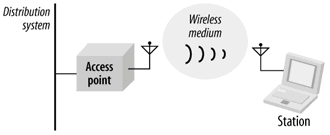Nomenclature and Design
802.11 networks consist of four major physical components, which are summarized in Figure below.

The components are:
Stations
Networks are built to transfer data between stations. Stations are computing devices with wireless network interfaces. Typically, stations are battery-operated laptop or handheld computers. There is no reason why stations must be portable computing devices, though. In some environments, wireless networking is used to avoid pulling new cable, and desktops are connected by wireless LANs. Large open areas may also benefit from wireless networking, such as a manufacturing floor using a wireless LAN to connect components. 802.11 is fast becoming a de facto standard for linking together consumer electronics. Apple's AirPort Express connects computers to stereos via 802.11. TiVos can connect to wireless networks. Several consumer electronics companies have joined the 802.11 working group, apparently with the intent of enabling high-speed media transfers over 802.11.
Access points
Frames on an 802.11 network must be converted to another type of frame for delivery to the rest of the world. Devices called access points perform the wireless-to-wired bridging function. (Access points perform a number of other functions, but bridging is by far the most important.) Initially, access point functions were put into standalone devices, though several newer products are dividing the 802.11 protocol between "thin" access points and AP controllers.
Wireless medium
To move frames from station to station, the standard uses a wireless medium. Several different physical layers are defined; the architecture allows multiple physical layers to be developed to support the 802.11 MAC. Initially, two radio frequency (RF) physical layers and one infrared physical layer were standardized, though the RF layers have proven far more popular. Several additional RF layers have been standardized as well.
Distribution system
When several access points are connected to form a large coverage area, they must communicate with each other to track the movements of mobile stations. The distribution system is the logical component of 802.11 used to forward frames to their destination. 802.11 does not specify any particular technology for the distribution system. In most commercial products, the distribution system is implemented as a combination of a bridging engine and a distribution system medium, which is the backbone network used to relay frames between access points; it is often called simply the backbone network. In nearly all commercially successful products, Ethernet is used as the backbone network technology.
In this tutorial:
- 802.11 Networks
- IEEE 802 Network Technology Family Tree
- Nomenclature and Design
- Types of Networks
- Independent networks
- Infrastructure networks
- Extended service areas
- Multi-BSS environments: "virtual APs"
- Robust security networks (RSNs)
- The Distribution System, Revisited
- Interaccess point communication as part of the distribution system
- Wireless bridges and the distribution system
- Network Boundaries
- 802.11 Network Operations
- Network Services
- Station services
- Distribution system services
- Confidentiality and access control
- Spectrum management services
- Mobility Support
- Designing Networks for Mobility
